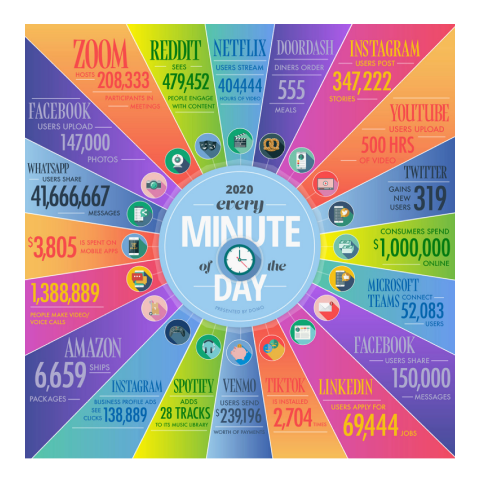Monitoring the performance of social media content through tracking engagement, activity and reach is important to ensure it is aligned with the social media strategy. It is also important to monitor issues that arise in social media platforms so that action can be taken early to limit a negative impact to the brand.
By the end of this topic, you will understand:
- Communicating a social media strategy and plan with the organisation
- Monitoring social media platforms for issues
- Tracking social media engagement and activity
- Monitoring the posting of social media content.
After developing a social media plan, it is important to communicate the plan with the relevant personnel across the organisation.
Content that is published to social media platforms is available to the world, and by ensuring the key stakeholders in the business are aware of what will be published and when, they will be able to respond to enquiries and potential issues.
Firstly, take some time to decide who those people are. For example, they could include:
- Higher management (CEO, directors, etc.)
- The marketing manager and team
- Frontline personnel
- Other key stakeholders
It is also necessary to ensure that any key activities defined in the social media calendar are communicated with the relevant people. For example, a cafe running a Facebook competition for free coffees should ensure that all cafe employees on shift during that period are aware of the competition and its terms and conditions.
Depending on the organisation, there may be a number of ways to communicate the strategy, action plan and the relevant policies and procedures, for example, through:
- Face-to-face training sessions
- Online training
- The organisation’s intranet
- Any internal communication platforms (such as Yammer or Slack)
As you execute a social media strategy, action plan and calendar, it is important to refer regularly to the crisis management policy and procedure. Where required, action will need to be taken in accordance with the social medial strategy to ensure that the brand endures as little negative impact as possible and the likelihood of future occurrences is minimised.
Case study

Nike and Zion Williamson
In 2019, star basketball player Zion Williamson from Duke University suffered a knee injury when the Nike shoe he was wearing fell apart. The game was broadcast nationally, and social media channels lit up. Barack Obama was courtside at the time and tweeted his best wishes to Zion, along with Zion’s fans who sent hundreds of thousands of tweets, likes and comments.
The following day, Nike stock dropped 1.8%. Nike released a statement expressing concern for Williamson and visited the manufacturing site in China, and around one month later, Williamson returned to the game with custom Nike shoes and thanked Nike for creating them.
The immediate response from Nike, along with the care it showed for Williamson, and its commitment to continuous improvement saved Nike from a social media and public relations disaster.
Adjusting and improving
Policies and procedures may need adjusting and improving as the social media action plan and calendar progresses. It is good practice to document issues as they arise, no matter how small, so that they can be assessed for future improvement opportunities. It may also be useful to monitor the social media activities of similar organisations in the industry. What actions do they take when issues arise? What impact do these actions appear to have on their brand, or their customers? This information will help to continually improve an organisation’s own policies and procedures.
A schedule should be established to track the engagement, activity and reach of an organisation’s social media activities. It may be influenced by the frequency of activity or posts. It is also important to decide how social media engagement will be tracked.
For example, it may be easiest to use the analytics page for each social media account. Or, if social media platforms have been integrated with the organisation’s existing customer relationship management (CRM) solution, it may be a better option to use the CRM as it can typically provide more sophisticated reporting capabilities than social media platforms’ own analytics.
Note:
What is tracked and how it is tracked should be aligned with the key performance indicators (KPIs) established for the social media strategy and activities.
With billions of people worldwide using social media platforms, there is a lot to monitor. Consider the following infographic that was created by Visual Capitalist to show what happened every 60 seconds online in 2020:

- Zoom - hosts 208,333 participants in meetings
- Reddit - sees 479,452 People engage with content
- Netflix - users stream 404,444 hours of video
- Doordash - diners order 555 meals
- Instagram - users post 347,222 stories
- Youtube - users upload 500 hours of video
- Twitter - gains new users 319
- $1,000,000 - consumer spend online
- Microsoft Teams - connect 52,083 users
- Facebook - users share 150,000 messages
- LinkedIn - users apply for 69,444 jobs
- TIktok - is installed 2,704 times
- Venmo - users send $239,196 worth of payments
- Spotify - adds 28 tracks to its music library
- Instagram - business profile ads see 136.889 clicks
- Amazon - ships 6,659 packages
- 1,388,889 video/voice calls
- $3,805 spent on mobile apps
- WhatsApp - users share 41,666,667 messages
- Facebook - users upload 147,00 photos
With the volume of data and consumers online, it is important to make sure that a brand and its online presence is continually monitored. It is also highly valuable to monitor the brand’s industry as a whole.
‘Social listening’ is the term used for monitoring a brand’s social media channels. The brand, or organisation, must ‘listen’ out for:
- Customer feedback
- Direct mentions
- Specific keywords or hashtags
The benefits of social listening are:
- Increased customer satisfaction when a brand responds appropriately to a conversation
- The ability to track a brand’s growth, for example, if a rise in negative or positive comments contributes directly to the number of followers or sales
- The ability to identify opportunities to improve a product or service by monitoring followers’ relevant posts, for example, if many customers are complaining about similar issues, steps can be taken to address those issues
- An expansion of the customer base through discovering the content people like to see and follow
There are a number of social listening tools available such as HubSpot, Sprout Social and Hootsuite.
Such tools often also allow the planning and scheduling of posts.
Always ensure that the monitoring of social media content is aligned with the brand’s social media strategy and the policies and procedures in place.
Activity

